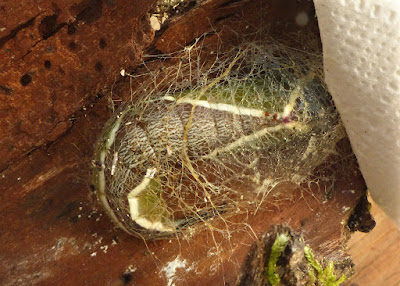71.003 Puss Moth eggshells with exit holes found near the larvae mentioned above. They too were on the upper side of one of the Aspen leaves.
71.003 Puss Moth larva, June 16th 2023, details above. This one is a mid-instar larvae at 14mm. Anthony Arak and I took three each to rear through which turned out to be a wise move as building work soon began on nearby Hollin Hall and all of the small Aspen saplings were eventually destroyed.
71.003 Puss Moth larva, June 16th 2023, details above. This rather dull looking one was pre-moult, it shed its skin the next day - which they then eat!
71.003 Puss Moth larva at 22mm along with moulted skin on June 21st 2023, details above. They are growing quickly now, another moult and another wonderful metamorphosis.
71.003 Puss Moth larva, June 29th 2023. They're now in their final instar and eating like crazy, this one's 55mm.
71.003 Puss Moth larva, June 29th 2023. They now have large "heads" and false eyes and are capable of spraying formic acid at would-be predators.
71.003 Puss Moth pre-pupal larva on July 7th. Just over three weeks after finding the larvae the first one is now beginning to spin up, at last!
71.003 Puss Moth cocoon some days later. After seeing their initial, transparent, silken spinnings I thought that they had neglected to utilise the bark provided but the next day I was amazed to see this beautifully constructed cocoon incorporating chewed up bark - just like the books said they would.
They will now be overwintered outdoors until the spring.
71.003 Puss Moth having just emerged on Mar. 26th 2024, details above. Nearly seven weeks after bringing this pupa indoors the moth has finally emerged.
The incredibly tough cocoon with exit hole is also shown.
71.003 Puss Moth, the one pictured above a day later having been released in to the garden. After its photo shoot it was placed in a sheltered, shady spot in the garden.
71.003 Puss Moths on May 10th 2024. The third and final cocoon was left in the garden to let nature take its course.
I casually checked it for the first time in a couple of weeks and was taken aback to see not one moth but two - a mating pair!
A female had emerged from the cocoon and not only had her pheromones attracted this male but there was another on the nearby fence, and who knows, there may have been even more that flew off as dawn approached.
A lovely end to my Puss Moth rearing adventure.
71.005 Sallow Kitten larva found feeding on Crack Willow at Tag meadow, Cromwell Bottom on July 19th 2018 - a field observation. The shed larval skin from the previous instar is to the right.
71.005 Sallow Kitten larva, details above. The whip-like appendages at the rear are inflated as a defensive strategy aimed at potential predators.
It was taken to rear through.
71.005 Sallow Kitten larva July 27th, details above. After not feeding for a day or two and just hanging upside down on the lid of the rearing pot every larva's worst nightmare came true. Parasitic wasp grubs started to emerge from all parts of its thorax and abdomen.
I suppose their habit of feeding openly on the upperside of leaves does make them vulnerable to wasp attacks but some obviously make it through okay.
You would think that after emergence the grubs would disperse and shuffle off the edge of the leaf and fall in to the leaf litter below to spin up but surprisingly they all kept very close to their host. I've seen this behaviour before with parasitic wasp grubs and ladybirds where they immobilise the host's legs from the inside and pupate underneath the body using the host's defensive strategies to protect them for as long as possible. In this case the Kitten larva remained alive for two more days, rearing it's pincers whenever I approached.
71.012 Iron Prominent to MV light at Mirey Wall farm near Sowerby on June 24th 2022. A stunning moth and much underrated in my opinion.
71.013 Pebble Prominent to MV light at Mirey Wall farm near Sowerby on Aug. 12th 2022.
71.013 Pebble Prominent resting next to the Robinson trap on North Loop, Cromwell Bottom on Aug. 2nd 2025.
71.018 Lesser Swallow Prominent to actinic light at Clock Face quarry, Krumlin on July 24th 2024.
71.020 Pale Prominent, one of two to MV light near the visitor centre at Cromwell Bottom, Aug. 3rd 2018. The archetypal "dead twig" camouflage.
71.021 Coxcomb Prominent to MV light at Blake Dean, June 7th 08.
71.025 Buff-tip larvae feeding on the garden rose bush at Skircoat Green, July 27th 2017. After several were taken to rear through the rest were soon predated, quite possibly by roving parties of Blue and Great Tits.
71.025 Buff-tip larvae, Aug. 11th 2017. Two of those taken to rear through from the batch pictured above.
71.025 Buff-tip larva, one of several found amongst the leaf litter at Hardcastle Crags on Sept. 15th 2016 by fellow workmate Lee Carney.
71.025 Buff-tip reared from the larva pictured above, Apr.17th 2017. With a forewing of 29mm this is probably a female. A fantastically well camouflaged moth on the right tree, obviously not on this manky old apple tree.
71.025 Buff-tip to LED light at Black Brook, Branch road on June 1st 2025. Funny how a good proportion of these moths appear to have "landed" on snapped off twigs!































+3..jpg)


No comments:
Post a Comment